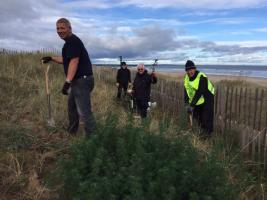Speaker - Dr Bess Rhodes on the Upheaval of 1559
Tue, Oct 20th 2020 at 7:00 pm - 8:30 pm
Hosted by Marilyn Rowan Rhind
Reception - Forbes Lockhart,
These may be difficult times for St Andrews – and everywhere else, for that matter. But back in the mists of time in 1558, there was just as much a problem for St Andrews. This became known as The Reformation.
St Andrews University researcher, Dr Bess Rhodes joined the Club’s latest Zoom meeting to use her expertise in reconstructing history with the aid of digital technology. Dr Rhodes showed slides which were illustrations of the actual documents and letters of the time.
Her history lesson centred mainly on the events of 1558 and 1559, which were prompted by the marriage of Mary Queen of Scots to the French Dauphin. The Scottish Parliament then agreed that French subjects should be treated equally with Scots, enjoying the same civil rights in trade, property and so on.
Such agreements raised the ire of John Knox and his many supporters, who wholeheartedly embraced Protestantism. All this meant St Andrews was a focus for unrest and protest in that year, not least because the Town boasted the largest building in Scotland – St Andrews Cathedral. The Cathedral was naturally a central point for Roman Catholics, not only in Scotland but from all over Europe.
Onto 1559, the reformists increase their efforts to pronounce Scotland a Protestant country.
In February 1559 the Bishop of St Andrews summoned priests and preachers to the Town for discussions. The Queen Regent had also asked the nobility to give their views regarding the possibility of reformation.
In April, the Catholic clergy stated they were “looking to take wholesale precautions against the perils that threatened them”. Not too difficult to figure out where the “perils” were coming from…
The following month the Clergy’s opposition ramped up severely when, in Perth, the Queen Regent, her counsellors and priests commanded the Scots people “under pain of death to desist from their blaspheming”. In other words, “do not disagree with us!”
Dr Rhodes was clear in her view that the country during that period of 1559 “was on a knife edge”.
And St Andrews was in clear danger. In June there was “a raising of arms” in defence of the Protestant reformers which resulted in the ransacking of the church in Crail, then a march to St Andrews.
Also, in that month John Knox created probably his most-quoted sermon, in which he compared his mission to the occasion when “Christ drove forth the buyers and sellers out of the temple. The Papists and idolators should be driven forth from the Kirk of God.”
In essence, St Andrews became a reformed place and the measures evolved to 1561 when Protestantism was enforced in Scotland. The legacy of 1559 carried on to 1655 with the destruction of religious buildings. The Reformation saw “all churches defaced or pulled to the ground”.
(Bess is a researcher with the University of St Andrews' Open Virtual Worlds group (which focuses on using digital technologies in history and heritage). Her recent book - 'Riches and Reform' - explored the economic upheaval caused by the Scottish Reformation, and its consequences for the burgh of St Andrews).
'What We Do' Main Pages:
